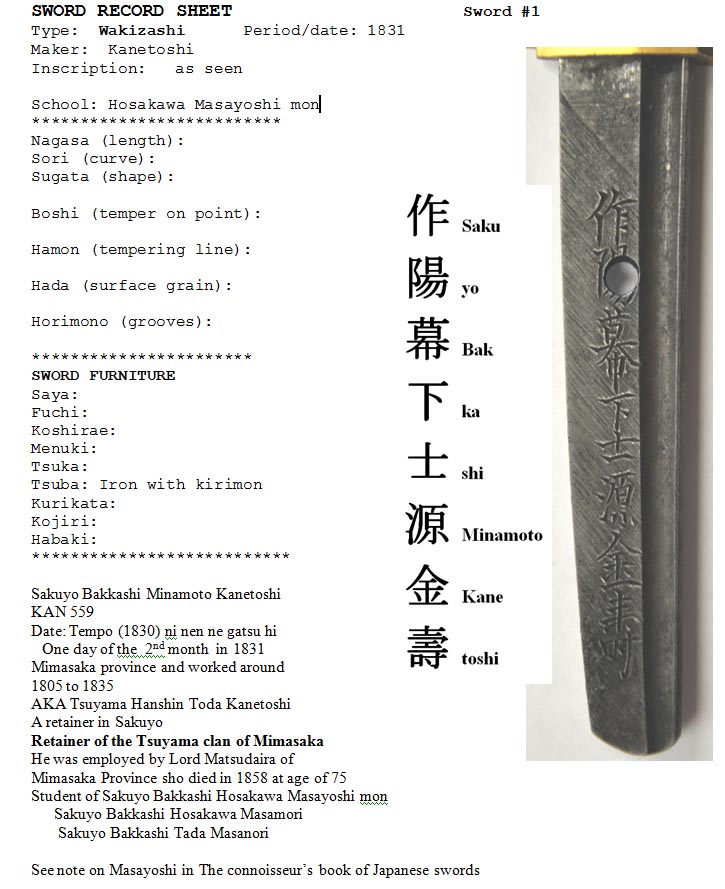Translation of Japanese Sword signatures

Translations
Go Back to my homepage
I can translate/identify the Kanji
(the Japanese characters,
the signature)
on most swords and fittings. I charge a nominal fee of $25 (see below).
To the far right is an example.
In order for me to translate the information on your blade you need to make an oshigata (rubbing)
and send it to me. This requires that you remove the hilt and get an
image of the characters on the blade through any of several methods.
In all methods you must remove the tsuka (hilt), seppa (spacers),
tsuba (hand guard), and habaki (sword collar) from the sword.
To remove the tsuka (hilt) you will find a mekugi (bamboo pin) that is
pushed through the tsuka (hilt). Once the mekugi (bamboo pin) is removed the hilt
can be removed. Note that some swords may have two pins. Wrap the bare blade with a chamois
or cloth to protect you and the blade from damage.
See Care of a Japanese Sword part III. Method of Maintenance
section b - Method of Sword Care for information on stripping sword fittings.
Method of Maintenance
Photographic method or Scanning
You can use a camera and photograph the nakago (tang of the sword).
If you need to add contrast to the characters try rubbing some white chalk
or face make-up foundation powder
into the characters and then photograph. You will have to adjust the light
so that the signature is visible.
When you are finished remove the chalk or powder with a dry toothbrush.
Do not disturb the rust on the nakago.
The black and red rust help identify the age of the blade.
Once you have your image please crop the image to remove unwanted space in the image.
Or you can place the nakago on a scanner and take a 300 dpi. Make sure
to crop out all unneeded space to show just the nakago.
Ink stone method
In this method you use a black inkstone rubbed on a piece of rice paper.
The rice (mulberry) paper can be found in many bookstores that carry Japanese
books or art stores that carry a variety of papers in the US.
Place the sword flat and securely on a table.
On top of the nakago (tang) place the rice paper.
Use the inkstone to gently rub on top of the paper.
The impressions of the signature will show up on the paper as light spaces
surrounded by ink.
You can try rubbing a pencil (such as a carpenter's pencil) on top of
a sheet of typing paper. This works but not as well.
Carbon paper method
In this method you use carbon paper, typing paper and a dowel.
Place the carbon paper on the sword's nakago (tang) carbon-side up,
then place the typing paper on top. Round the end of the dowel.
Use the rounded end of the dowel to gently rub on the paper.
Pressure-sensitive paper method
There is a pressure-sensitive paper that can also be used.
Smoking and tape method
In this method you use the soot from a candle, Scotch Magic tape,
and white typing paper.
Light the candle and let it burn until you have a nice long flame.
Wrap the sword blade in a towel or chamois.
While holding the sword blade wrapped in chamois or cloth,
and above the candle, pass the very top of the candle
(the coolest part of the flame) across the signature to soot the area.
Take care to not heat up the blade.
The blade should never get hot enough so that you cannot hold onto the tang
without burning yourself. After sooting the signature, put the sword flat
and securely on the table. Take off a strip of Scotch Magic tape and
careful place on tang. For most tangs you will need to overlap the tape two
or three times. After the tape is in place on the tang, rub the top of
the tape with your fingertip to make the characters show up. Them remove
the tape and place on a piece of white paper.
When you are finished, remove the soot first with a dry cloth or tissue.
Next wash the tang with a mild soap and rinse.
Dry the tang and then remove the cloth on the blade and oil and uchiko
the blade. Do not disturb the rust on the nakago.
The black and red rust help identify the age of the blade.
With this oshigata (rubbing) you can then snail mail it to me or scan it and
send me a jpg file (best to be in the 500 to 1000 kb size). I charge a nominal fee of $25. I will translate
the oshigata and find out as much as I can about the stated smith of the sword. Place
all of the information on a Sword Record sheet and email you a copy. Then
will try to answer any questions you might have about your sword.
You can pay with a check/money order mailed to me or paypal.
David W. McDonald
PO Box 265
Sidney MT 59270
Return to top of page.
Go Back to my homepage
Copyright 2025 Montanairon.Com - All Rights Reserved.
All contents of montanairon.com, unless otherwise noted, are copyright 1994-2025 by montanairon.com.
